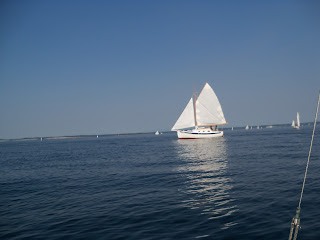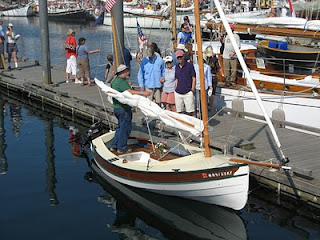The Grand Sailby is the parade of boats that marks the end of the Festival. All of the boats depart the festival beginning at about 2:00 and join the 90 minute long parade just offshore of the festival grounds. They are joined by boats from Boat Haven marina and by many dozens of spectator boats. Hundreds of spectators line the shores, the breakwater, and the Maritime Center to cheer the boats. The Festival gatekeepers abandon their posts, allowing many friendly Port Townsend locals to join the fray. The Sailby is followed by hundreds of fond Farewells. Boats ranging from dinghys and kayaks to schooners and square riggers, tugboats, steam powered vessels, motorboats, all manor of sailing craft, and everything in between are suddenly everywhere. It's quite a sight to see.
I took a break and headed over to the Small Craft Advisor Magazine tent to see what was up. Several of us chatted for a while and it was then when we came up with the idea which was later dubbed the "Rugby Scrum". The plan was to try to get all four Welsford boats, and a photographer from Small Craft Advisor Magazine, close together during the Sailby for a photo op. Maybe, with a bit of luck, the photo would be good enough to make the pages of the magazine. Now that would be awesome!
The plan was to meet around Scamp, piloted by Howard Rice, John Welsford and John's wife Denny.
A few hours later, off we all went! As we left Port Hudson, we could see the Sailby beginning to form off in the distance.
Soon we were in the middle of it, surrounded by boats.
Now we just need to find Scamp. A bit like finding a needle in a haystack!
Oh, hey! There's Mike in Jean Alden. Hi Mike!
Then I spotted her. Scamp! There she is near the shore entertaining a huge crowd of spectators! Head thataway!
And there is Rick's Walkabout "Puddles" headed toward Scamp, rowing faster than I can sail!
And Tenacious? She should be easy to spot. There she is, headed towards Scamp from the SouthEast!
We all converged on Scamp, circled around one another several times, and then lined up for the family photo. I heard a cheer come from the spectators on the beach, but I don't know if they were cheering us or something else.
We did it! Will it make the magazine? Only time will tell.
Nearly close enough to shake hands, we all shouted fond farewells, and just like that, the 35th Annual Port Townsend Wooden Boat Festival, the best one ever, was over.
































































